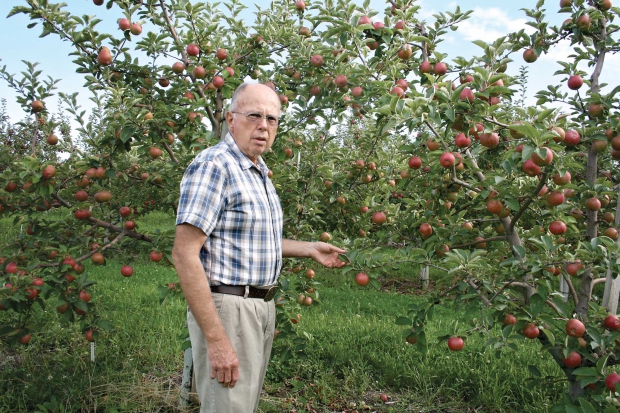
Peter Ringsrud says he finds his Dabinett cider apple trees even more sensitive to fireblight than his Bartlett pears. (Geraldine Warner/Good Fruit Grower)
Peter Ringsrud, whose family owns Snowdrift Cider Company in East Wenatchee, Washington, says he can’t keep up with demand for the hard cider they produce.
“We keep having calls from all over the United States for our cider and we’re not serving Washington well, let alone the Northwest,” he said during a cider workshop in Moses Lake last spring.
Ringsrud began making cider on a small scale after taking a class with U.K. cider expert Peter Mitchell in 2004. He learned that his previous experiments had failed because he’d used dessert apples from his orchard that had no flavor once the sugar had fermented.
“About the best I could do was horrid,” he said.
Armed with this new insight, he bought traditional bittersharp and bittersweet cider apples from a local grower and made a few carboys of cider that were pale straw to deep amber in color with incredible flavor components.
Since he had no land to plant additional trees, he grafted over one and a half acres of Red Delicious trees to 11 cider varieties. The next year, he made another 200 gallons of cider for taste tests, and then grafted more trees.
The family released their first 190 cases of cider in 2006. Their production has since grown to 2,500 cases, made from their own and other growers’ fruit. With the growth of the keg market, the family is undergoing a $250,000 expansion and has further expansion planned after that.
“We can’t keep up,” Ringsrud said. “In some ways, it’s exciting, but until we have the right fruit, we’re going to grow with what we’ve got.”
Ringsrud said he’s in discussions with orchardists who have small blocks they’re interested in grafting over to cider apples.
Challenges
Growing cider apples presents different challenges from growing dessert apples. Because cider apples are so variable in size and production, Ringsrud pays pickers by the hour. Even though he chemically thins with NAA (naphthaleneacetic acid) and Sevin (carbaryl) to reduce the fruit to singles and doubles, some varieties still fruit biennially. Production averages 30 to 40 bins per acre.
Of the varieties, Yarlington Mill is moderately biennial, but Ringsrud described Porter’s Perfection as “horrid,” with trees blanked out every other year. Kingston Black also has problems with fruit set.
Roxbury Russet is an exceptional cider and dessert fruit, but its idiosyncracy is that it goes from ripe to slop in about two days. However, he’s heard that in other parts of the country it matures slowly on the tree.
Dabinett is extremely sensitive to fire blight—more so than Bartlett. When symptoms first show up in the leaves, the branch needs to be removed immediately, he said, otherwise by the following day it can have run 12 to 15 inches down the wood.
He grows Snowdrift crabs, which are so small it can take a person all day just to pick two bins, when they could pick ten bins of a standard variety.
“But five percent of that concentrated juice adds an incredible complexity to the cider,” he said, “So I have to bite the bullet about how much it costs.”
Michelin, Nehou, and Muscadet de Dieppe can shed a third of the crop as they’re starting to mature, and Ringsrud is experimenting with stop-drop applications to prevent that.
Because some of the cider apples mature when he’s picking his commercial pear crops, he puts the cider apples in storage until after harvest is over. He focuses on bittersweet and bittersharp apples because of the valuable flavor components they lend to the cider, he said.
He starts pressing the apples as early in October as he can and finishes by Christmas. He does primary fermentation following a white wine model, then racks the cider and puts it back into stainless steel tanks for six months to develop the cider flavors.
“We enjoy what we’re doing,” he said. “It’s a lot of work, but the demand we have out there way outstrips our ability to supply it.”
Ringsrud spoke at the workshop “Hard Cider from Orchard to Shelf” presented by the Northwest Agriculture Business Center at Big Bend Commuity College, Moses Lake. •
—–
Editor’s note: A photo of cider apples that was published with this story incorrectly named the variety as Foxwhelp when it was not. That photo was removed from this story on October 6, 2014.






Leave A Comment